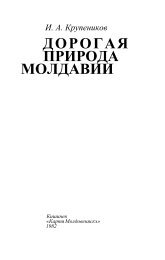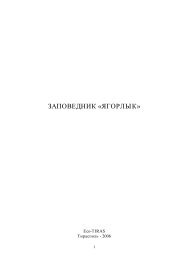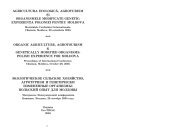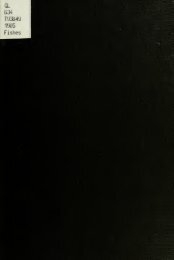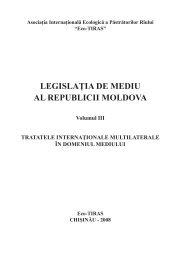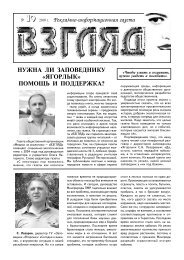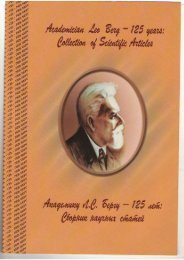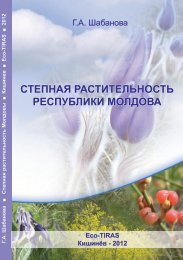WATER SAFETY PLANS (WSP) AND EXPERIENCESWITH SMALL-SCALE WATER SUPPLY SYSTEMSMargriet SamwelWomen in Europe for a Common Future – WECF, The NetherlandsEmail: margriet.samwel@wecf.eu, Website: www.wecf.euIntroductionThe Stockholm Framework (2001) provides aharmonized approach for the development of health-basedguidelines and standards in terms of water and sanitationrelated hazards. Coinciding with the development of thisframework was the realization that drinking water safetycould no longer be guaranteed solely through monitoringat the so-called ‘end of pipe’ and the increased need toaugment traditional sources of water supply (potable andnon-potable) with re-used water. Both of these factorsrequired a more preventative risk-based approach tomanaging water for the protection of public health.Hence the World Health Organisation (WHO) initiatedthe Water Safety Plans (WSP), which is to be consideredas a part of the WHO or other guidelines or directives ondrinking water quality. The WSP asks for an identificationof risks, which could affect water safety and human healthin every stage of the water supply.What is a Water Safety Plan?A Water Safety Plan (WSP) is a most effective way ofensuring that a water supply is safe for human consumptionand that it meets the health based standards and otherregulatory requirements. It is based on a comprehensiverisk assessment and risk management approach to allthe steps in a water supply chain from the catchment tothe consumer.The primary objectives of a water safety plan inprotecting human health and ensuring good water supplypractice are the minimisation of contamination of waterresources, the reduction or removal of contaminationthrough appropriate treatment processes and theprevention of contamination in the distribution networkand the domestic distribution system. These objectivesare applicable to all water supply chains, irrespective oftheir size or complexity.The WSP focuses on the safety of all the differentaspects of a water supply, which can vary from a large-scale supply providing water to several million consumersto a small-scale system, e.g. a bucket-well. The WSP isa concept to develop a process-orientated observation ofthe water supply and its goal is to identify and eliminate allthe possible risks in the entire water supply system: fromthe potential risks of water pollution in the catchment areaall the way along the line to the consumers.The approach of a WSP can be adopted to all waterand sanitation systems, such as surface water, rainwaterharvestingor sanitation facilities.The base of every Safety Plan is the understandingof the system and collection of all relevant informationabout the nature and properties of the water or sanitationsystem and the activities taken place in the target area 1 .Catchment• geology, hydrology, meteorology and weatherpatterns• nature of the land and it use, in particular degreeof urbanisation, industrial activities, animal rearing andarable farming, degree of natural land and its wildlife,quarrying and mining (that is uses and activities that couldgive rise to contamination of raw water sources)• competing water uses such as irrigation and rivercompensation flows• planned future activities• any existing catchment control and protectionzonesSurface water• type of water such as river (direct abstraction), river(abstraction in storage reservoir), impounding reservoir,lakeSource: DWI – A brief guide to drinking water safety plansOctober 2005Fig. 1. The components of a Water Safety Plan (WHO)— 195 —
• inventory of point discharges such as sewageeffluents, industrial effluents, water from mining• water quality and how it varies seasonally and withweather patterns• flow and reliability of source and retention time ifstored• recreational and other human activity• any existing source protection systemsGroundwater• confined or unconfined aquifer, hydrology andrecharge area• flow rate, direction of flow and dilutioncharacteristics• whether fast or slow response to activities andevents on surface• depth of casing and abstraction and any wellheadprotection• inventory of activities in the recharge area that couldaffect water qualityBased on the gathered knowledge hazardidentification and risk assessment with involvement oflaboratories, distribution network (services for watertreatment and pipes or others), health authorities andother stakeholders such as consumers, farmers orindustry is followed whereas all the elements andfindings should be documented and made accessible toall stakeholders and the public.Improvements in order to minimise the risks shouldbe planned and carried out with a broad involvement ofthe public.Detailed information about Water safety plans can befound in the WHO document: Managing drinking-waterquality from catchment to consumer 2 .Experiences with developing Water Safety Plansinvolving schoolsSince several years, WECF, in cooperation with localpartners, has been monitoring water pollution of smallscalewater supply systems such as dug wells in ruralareas of several countries such as Romania, Moldova orUkraine.Poor sanitary conditions and mismanagement ofhuman and agricultural waste cause anthropogenic(man-made) water pollution with nitrates, faecal bacteria.Despite the evidence provided, this has NOT triggeredany action by local or regional authorities to start waterprotection measures. Among the rural citizens andlocal authorities low awareness exists on the relationof anthropogenic pollution, water quality and relateddiseases. In villages with small-scale water supplysystems, financial mechanisms or structures for waterand sanitation are often not available.To address the above-mentioned problems WECFcreated an educational package (WSP toolbox) forschools to develop community based Water Safety Plans(WSP) for local small-scale water supply systems such asdug wells, boreholes and public taps 3 .The aim of the activities on developing WSP forsmall-scale water supply systems involving schoolswas, building local capacity and strengthening and2 http://www.who.int/water_sanitation_health/dwq/wsp0506/en/index.html3 http://www.wecf.eu/english/publications/2008/wspmanuals-revised.phpmobilising the community for improved access to safedrinking water. The WSP toolkit provides schools andother stakeholders with a WSP manual with backgroundinformation about the aims of the WSP, about propertiesof drinking water and sources of pollution and relatedhealth risks. Three different questionnaires wereprepared for the schools: one for citizens, one for thelocal medical staff and one for the authority responsiblefor the local water supply.Based on the sanitary inspection forms of the WHO,checklists for the risk assessment of water sources wereadapted to the local circumstances.Two teachers per participating school were trained byWECF on how to develop with the involvement of theirpupils a WSP for their local community. The schoolswere provided with materials and information for carryingout nitrate quick tests and organo-leptic observations,and were motivated to analyse local water sources andto carry out a longitudinal nitrate monitoring of selecteddrinking water sources.ImplementationIn autumn 2008, school staff of 8 Romanian schoolsdeveloped and started a WSP programme for their pupils.The teachers and the pupils of the participating schoolswere very motivated and enthusiastic about the activities,because the activities were experienced as practical,educative and relevant to the local environment. The resultsdepended considerable on motivation and available timeof the teachers and the pupils. Approximately 500 watersamples were tested for nitrate and other simple testslike pH, observing the turbidity or colour of the samples,were carried out. The pupils, including final conclusionsand recommendations, carried out many interviews andsanitary inspections.Results of interviews with the local water responsibleauthoritiesOne of the results of the interviews was that inone out of the 3 communities with public taps the wellsand the water quality was seldom monitored; for theother 2 communities with public taps regularly waterquality controls were carried out. Citizens have to paylittle money (0.5 Euro/m 3 ) for water delivered by publictaps, water provided by public wells is for free. Therespondents said that the authorities of the communesdo not have additional budget and there are not enoughfinancial means for operation and maintenance of thesystems.Hence water protection measures or maintenance ofthe water sources was very poor in the target villages.Results of interviews with the local health authoritiesThe local doctors of 6 villages answered thequestionnaire. On the question “What is in your opinion themain problem concerning drinking water in the village?“two doctors mentioned the pollution via animal droppings,septic tanks, lack of sewerage and the fact that water isnot tested or protected. In three villages partly served withpartly public taps, the main problem mentioned was partialor a total lack of water supply. Regarding the water quality,the doctors of the four villages mentioned the high nitratesand water infected with Giardia. Most of the intervieweddoctors of the target villages were aware of the lack ofaccess to safe water and related health problems.— 196 —
- Page 3 and 4:
Descrierea CIP a Camerei Nationale
- Page 5 and 6:
Уважаемые коллеги,
- Page 7 and 8:
щегосударственной
- Page 9 and 10:
доме, в котором мы в
- Page 11 and 12:
шие глубины на заде
- Page 13 and 14:
с малыми восстанов
- Page 15 and 16:
Литература1. Жадин
- Page 17 and 18:
Рис. 3. Многолетняя
- Page 19 and 20:
тера и глубины изме
- Page 21 and 22:
ПОДДЕРЖАНИЕ БИОРАЗ
- Page 23 and 24:
Таблица 5. Оптималь
- Page 25 and 26:
Таблица. Результат
- Page 27 and 28:
ФОРМИРОВАНИЕ БИОЦЕ
- Page 29 and 30:
Подавляющее больши
- Page 31 and 32:
Рис.1. Днестр вблизи
- Page 33 and 34:
сопоставимости дан
- Page 35 and 36:
ции с международны
- Page 37 and 38:
А.Н. Бургеля, К.П. Бу
- Page 39 and 40:
Выводы1. Уже на само
- Page 41 and 42:
тегории, виды и пор
- Page 43 and 44:
санитарно-эпидемио
- Page 45 and 46:
Таблица 4. Распреде
- Page 47 and 48:
реационных, монито
- Page 49 and 50:
Шабановой Г.А. и Кух
- Page 51 and 52:
могут быть убраны,
- Page 53 and 54:
Турунчук. Связь с с
- Page 55 and 56:
Праздник «День Рек
- Page 57 and 58:
500ЈPРис. Распределе
- Page 59 and 60:
Н. Гроссу * , Р. Шакир
- Page 61 and 62:
Рис.1. Помесячное ра
- Page 63 and 64:
Calitatea apei r. Nistru conform gr
- Page 65 and 66:
Карта геохимическо
- Page 67 and 68:
лесу был дуб, сегод
- Page 69 and 70:
При предварительно
- Page 71 and 72:
щих улучшить социа
- Page 73 and 74:
ней опасных загряз
- Page 75 and 76:
ФотоприложениеФот
- Page 77 and 78:
в Украине - одесска
- Page 79 and 80:
тия по гидрохимиче
- Page 81 and 82:
ветствующих санита
- Page 83 and 84:
ния полей, так и для
- Page 85 and 86:
В. Экономический ан
- Page 87 and 88:
Таким образом, плат
- Page 89 and 90:
Рис. 2. Динамика нор
- Page 91 and 92:
Табл. 1а. Статистиче
- Page 93 and 94:
Выводы1. Наибольшее
- Page 95 and 96:
Для днестровской в
- Page 97 and 98:
ЭКОЭТИЧЕСКОЕ ВОСПИ
- Page 99 and 100:
Таблица 1. Валовое с
- Page 101 and 102:
почвенный покров п
- Page 103 and 104:
always been the public concern of b
- Page 105 and 106:
и уникальными по си
- Page 107 and 108:
ются основными фак
- Page 109 and 110:
Рис. 4. Пораженность
- Page 111 and 112:
ight to use”. Varone et al. (2002
- Page 113 and 114:
mass media, etc., which belong to d
- Page 115 and 116:
В связи с тем, что К
- Page 117 and 118:
период поездки вых
- Page 119 and 120:
doutchinae (d’Orb.), выше з
- Page 121 and 122:
вместе с осадками в
- Page 123 and 124:
Таблица 4. Содержан
- Page 125 and 126:
efectuat în baza următorilor indi
- Page 127 and 128:
видуальных различи
- Page 129 and 130:
- соответствующее з
- Page 131 and 132:
ФАУНА КЛЕЩЕЙ ДРЕВЕ
- Page 133 and 134:
Таблица 1. Данные ра
- Page 135 and 136:
РЕКРЕАЦИОННЫЕ РЕСУ
- Page 137 and 138:
ЭТАПЫ ЭВОЛЮЦИИ БИО
- Page 139 and 140:
Плотина Дубоссарск
- Page 141 and 142:
чимые. При этом «пе
- Page 143 and 144:
Схематически получ
- Page 145 and 146: Таблица 5. Данные на
- Page 147 and 148: Risks for biodiversity with tested
- Page 149 and 150: 14. Ярошенко M.Ф., Дед
- Page 151 and 152: 20082009Fig. 2. Structure of shrew
- Page 153 and 154: с природой (различн
- Page 155 and 156: делить в их предела
- Page 157 and 158: Таблица. Оценка эне
- Page 159 and 160: лах Приднестровья
- Page 161 and 162: ВыводыКраеведческ
- Page 163 and 164: вий среды жизнедея
- Page 165 and 166: Senecio besserianus Minder. Cypripe
- Page 167 and 168: Рис.1. Почвенная кар
- Page 169 and 170: половины площади п
- Page 171 and 172: Рис. 2. Современное
- Page 173 and 174: ПРИЧИНЫ ГЕОМОРФОЛО
- Page 175 and 176: RÂURILE MICI CU ŞANSE MARIDE A FI
- Page 177 and 178: ЭКОНОМИКО-ЭКОЛОГИЧ
- Page 179 and 180: прибрежной зоной (п
- Page 181 and 182: Строительство в пр
- Page 183 and 184: государственного у
- Page 185 and 186: ческий, социальный
- Page 187 and 188: ми, послужило весом
- Page 189 and 190: губительно влияющи
- Page 191 and 192: ных за контролем и
- Page 193 and 194: PECULARITIES OF DYNAMICS OF PHOSPHO
- Page 195: Fig. 4. Spatial and seasonal dynami
- Page 199 and 200: СТЕРИЛИЗАЦИЯ КАК С
- Page 201 and 202: гормоны (в незначит
- Page 203 and 204: ПРОТОКОЛ ПО ПРОБЛЕ
- Page 205 and 206: воды ежегодно умир
- Page 207 and 208: РАЗРАБОТКА ПЛАНОВ
- Page 209 and 210: ставляет материаль
- Page 211 and 212: • Совершенствован
- Page 213 and 214: «Алые паруса». Таки
- Page 215 and 216: which the Committee is then require
- Page 217 and 218: нием, культурой и х
- Page 219 and 220: - Николаевская церк
- Page 221 and 222: Сброшенный на 50 м б
- Page 223 and 224: СТРУКТУРА ГЕОИНФОР
- Page 225 and 226: 4. Пространственная
- Page 227 and 228: На фазе пика числен
- Page 229 and 230: А.А. Тищенков, В.В. М
- Page 231 and 232: Распределение видо
- Page 233 and 234: цветковый (ККП, ЧКУ,
- Page 235 and 236: очередной задачей
- Page 237 and 238: схемой планировани
- Page 239 and 240: эксплуатационным п
- Page 241 and 242: ных дамб, с возвращ
- Page 243 and 244: ледствия от урбани
- Page 245 and 246: ОСНОВНЫЕ ФОРМЫ ДЕГ
- Page 247 and 248:
УЧАСТИЕ НЕПРАВИТЕЛ
- Page 249 and 250:
струкции как от сбр
- Page 251 and 252:
Рогоз широколистны
- Page 253 and 254:
Таблица 3. Изменени
- Page 255 and 256:
В рамках первых тре
- Page 257 and 258:
Основные экскурсио
- Page 259 and 260:
2. Кравченко Е.Н. При
- Page 261 and 262:
Decision-Maker user group are respo
- Page 263 and 264:
может ее запускать,
- Page 265 and 266:
поражения населени
- Page 267 and 268:
тию РДЮЦ «ГУТТА - кл
- Page 269 and 270:
мость разработки н
- Page 271 and 272:
Биология. Подорожн
- Page 273 and 274:
банизированных тер
- Page 275 and 276:
Результаты исследо
- Page 277 and 278:
площадь ассимиляци
- Page 279 and 280:
Рис. 3. Дендрограмма
- Page 281 and 282:
Рис.1. Сезонная дина
- Page 283 and 284:
Молдовы и Приднест
- Page 285 and 286:
Ребята приехали в 10
- Page 287 and 288:
Рис. 1. Численность
- Page 289 and 290:
жений, в том числе э
- Page 291 and 292:
[4]. Несомненно, выжи
- Page 293 and 294:
КОНСТИТУЦИОНАЛЬНА
- Page 295 and 296:
В настоящее время б
- Page 297 and 298:
8. Суворцева В.Ю., Ру
- Page 299 and 300:
Окончание табл. 2Ок
- Page 301 and 302:
содержаниеПРЕДИСЛ
- Page 303 and 304:
А.П. Погребняк, В.Ф.
- Page 305:
Научное изданиеБАС


![[download]13,2 Mb - Eco - Tiras](https://img.yumpu.com/50284532/197/500x640/download132-mb-eco-tiras.jpg)
